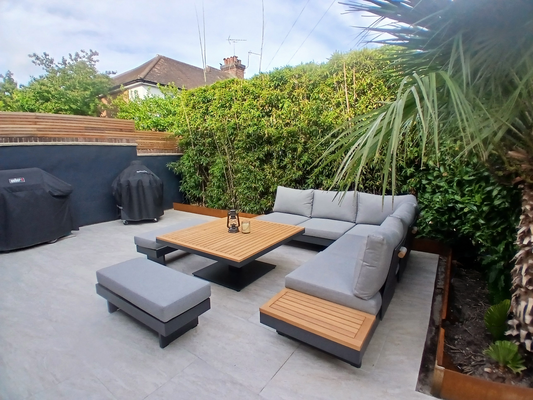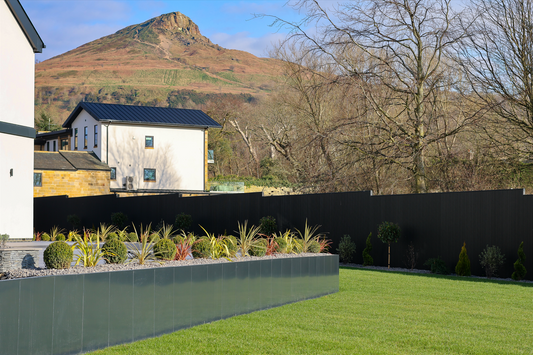
Child and Pet-friendly Garden: What does this mean?!
Creating a kid- and pet-friendly garden is all about designing a space that’s beautiful yet practical, prioritizing safety, accessibility, and durability. Here’s a guide to crafting a garden that both kids and pets can enjoy safely and freely, ensuring a harmonious space for family fun and relaxation.
1. Choose Non-Toxic Plants
Safety begins with plant selection. While plants like daffodils and lilies are beautiful, they can be toxic if ingested by pets or children. Instead, consider non-toxic options like:
- Lavender - Known for its calming scent, it’s non-toxic to both kids and pets.
- Sunflowers - Hardy and vibrant, sunflowers are safe and can add a cheerful element to the garden.
- Ferns - Some fern varieties, like the Boston fern, are safe and add lush greenery to any garden.
Pro Tip: Avoid any plants with sharp thorns or spikes, like roses or cactus, especially at child height.
2. Create Safe Boundaries and Barriers
If your garden has spaces you’d like to keep off-limits, like vegetable patches or ponds, a child- and pet-friendly boundary is essential. Here are some ideas:
- Low, Decorative Fencing - Keeps pets and little ones out of restricted areas.
- Steel Edging - Systems like our Contour steel edging offer strong, durable boundaries that can also prevent soil from spilling onto pathways, reducing tripping hazards.
Having sturdy boundaries gives parents peace of mind and helps pets understand the limits of their play areas.
3. Opt for Soft, Durable Surfaces
Hard surfaces can lead to scrapes or even serious injuries if falls happen. Instead, consider:
- Grass - The classic kid- and pet-friendly ground cover, perfect for play.
- Bark or Mulch - Offers a soft surface while being low-maintenance.
- Rubberized Play Mats - Ideal for areas dedicated to kids' play equipment.
Soft surfaces not only provide cushioning but are also less likely to wear down quickly from frequent play and foot traffic.
4. Provide Shade and Cozy Rest Spots
Kids and pets both need a place to cool off in hot weather. Adding shade keeps the garden usable during warmer months:
- Trees and Pergolas - Trees offer natural shade, and pergolas can provide structure for growing vines.
- Covered Benches or Outdoor Tents - A cozy spot where pets can lie down or where kids can retreat to read or nap.
These shaded areas give everyone a place to unwind and stay cool while being close to the garden action.
5. Install Safe Edging and Borders
Sharp or unstable borders can be hazardous. Instead, choose smooth, rounded edges or durable metal options:
- Steel Edging Solutions - Products like Contour steel edging keep garden beds neat, resist soil movement, and withstand rough use, all without exposing dangerous sharp edges.
- Low Raised Beds - Adds structure and height, creating distinct zones that are visible to children and easy for pets to navigate.
Durable, safe borders define garden areas while minimizing risks associated with unstable or sharp materials.
6. Avoid Chemical Fertilizers and Pesticides
Conventional fertilizers and pesticides often contain chemicals harmful to both kids and pets. Safer alternatives include:
- Organic Fertilizers - Plant-based composts or manure enrich the soil naturally.
- Companion Planting - Certain plants repel pests naturally, reducing the need for chemical intervention. For example, marigolds deter aphids.
Opting for non-toxic garden care means less worry about accidental ingestion or skin contact with harmful substances.
7. Design Play Zones and Pet Areas
Designating areas for play and specific pet activities keeps the entire garden more organized:
- Kids’ Play Zones - Adding sandpits, climbing structures, or even water features can create exciting areas for kids.
- Pet-Friendly Spots - Some pets love to dig, so consider adding a "digging pit" with loose soil. Planting pet-safe grasses and herbs (like catnip for cats) can also create areas they enjoy.
By giving each group their own areas, you can minimize mess while allowing space for energetic play.
8. Keep Pathways Clear and Safe
Pathways should be level, easy to navigate, and safe for little feet and paws. Consider:
- Non-Slip Materials - Gravel, flagstone, or textured pavers reduce the risk of slipping, even when wet.
- Smooth Transitions - Avoid uneven steps or sharp drops to reduce tripping hazards.
These features help maintain a clear and safe walking surface for everyone, keeping the garden accessible year-round.
Final Thoughts
Building a kid- and pet-friendly garden combines thoughtful plant choices, smart landscaping, and safety-conscious design. With these elements, you’ll create a beautiful outdoor space where everyone in the family—including the furry members—can explore, play, and relax freely.



